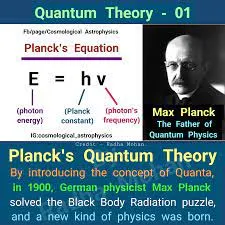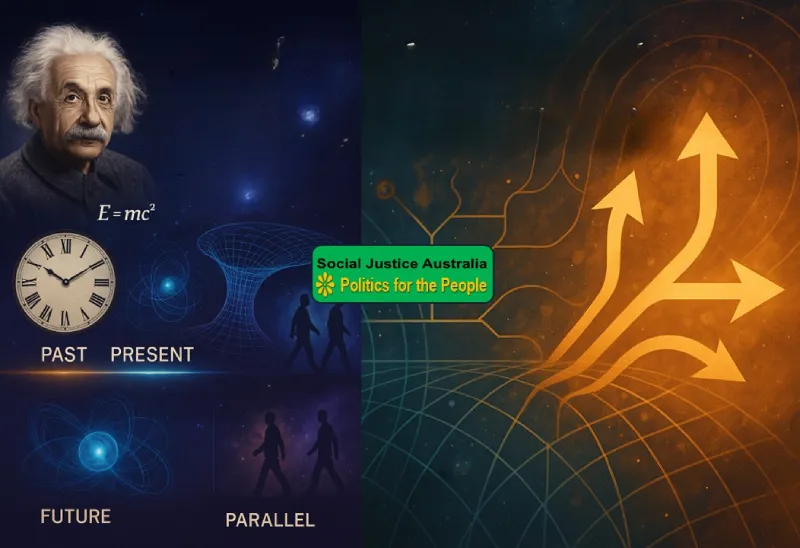Description
How Einstein’s quantum theory may reveal our future. Discover how small actions today could reshape tomorrow’s world.
Introduction – Are We Living in One of Many Possible Futures?
Picture this: A scientist in 1905 scribbles equations in a Swiss patent office, unknowingly rewriting time. Fast-forward to today — our world feels like it’s spiralling: climate chaos, inequality, tech surveillance, and political apathy. What if this moment was always going to happen? And what if, like particles in quantum physics, our next move could shift the outcome?
Welcome to the edge of reality, where Einstein’s relativity and quantum theory collide with politics, society, and choice. This isn’t just science — it’s a roadmap for humanity.
The Block Universe – Einstein’s Fixed Past, Present & Future
Einstein’s theory of relativity shattered the classical view of time. He introduced the idea of the block universe — where time is the fourth dimension, and all moments (past, present, future) co-exist.
In this model:
• Time doesn’t flow — we move through it like walking through space.
• The future already exists, just as the past does.
Einstein himself said: “The distinction between past, present and future is only a stubbornly persistent illusion.”
Real-World Reflection: Our political systems often feel resistant to change, as if stuck in loops. But that’s because the path forward already exists — we just haven’t reached it yet.
Quantum Theory/Mechanics – A World of Uncertainty and Interconnection
Unlike Einstein’s deterministic model, quantum theory throws in unpredictability:
• Uncertainty Principle: We can’t know a particle’s position and speed at the same time.
• Entanglement: Particles are still connected across vast distances.
• Superposition: A particle can exist in multiple states until seen.
Ref: The Uncertainty Principle
Societal Parallel: Our world mirrors quantum systems:
Political decisions are often unpredictable. Like quantum particles, policies and political outcomes can shift dramatically based on seemingly minor inputs — a protest, a leaked document, a sudden economic report. These shifts echo quantum theory unpredictability, where we can only calculate probabilities, not certainties.
Global economies are deeply interconnected. Just as entangled particles affect one another across distance, economies ripple across borders. A policy change in one country can cause economic reverberations across the world, just as quantum theory entanglement links particles instantaneously. The COVID-19 pandemic and the 2008 financial crisis are real-world proofs of this complex entanglement.
Outcomes are still open — until we, collectively, observe or choose them. Much like a quantum state collapses into a definite outcome upon observation, societal futures remain fluid until collective decisions ‘lock in’ a path. Elections, referenda, public uprisings, and even viral social media movements act as measurements in our shared reality, defining the direction of our collective timeline.
This suggests that the future isn’t just something that happens to us — it’s something we participate in shaping, even if we don’t yet realise the full scope of our influence.
Applying Quantum Theory and Einstein’s Time Theories to Today’s World

Let’s look at how quantum theory uncertainty and Einstein’s time apply to current global challenges:
1. Climate Crisis
We’re near tipping points. Each policy, protest, or act of resistance is like a quantum measurement — locking in one path or another.
2. Inequality and Injustice
These are entangled issues: poverty, education, and housing are interlinked. Solving one needs a broader, systemic approach — just like untangling quantum states.
3. Authoritarianism vs. Collective Awakening
We’re at a fork in the timeline: digital surveillance or grassroots democracy? Both outcomes exist. The question is: which one will we realise?
Prediction – What Future Are We Likely to Create?
If we follow current trends — rising inequality, privatisation, political capture — the likely outcome is:
• Digital control over civil life.
• Climate-driven migration and resource wars.
• Widening gaps between rich and poor.
But quantum theory reminds us:
• Multiple outcomes are possible.
• Observation and action shape results.
A better future is also likely if enough citizens choose:
• Transparent governance
• Economic reform using Australia’s dollar sovereignty.
• Climate action led by Indigenous wisdom and science.
The Tipping Point – How Many People Can Change the World?
Studies prove that it doesn’t take a majority to spark massive change:
1. The 3.5% Rule (Erica Chenoweth)
Nonviolent protests that engaged at least 3.5% of a population succeeded in over 50% of cases. In Australia, that’s just 900,000 people. Source
2. Social Contagion & Network Theory
Once 10–25% of a population adopt an idea, it can spread rapidly across the majority. That’s how revolutions — and paradigm shifts — happen.
3. Historical Examples
From civil rights in the US to Indigenous land rights in Australia, change has always begun with a passionate few.
✅ We don’t need everyone — just enough committed people to influence the timeline.
Conclusion – Choice, Time & the Human Experiment
The theories of Einstein and quantum theory physics offer not just explanations, but metaphors. We’re not passive in this timeline. We’re agents in a cosmic experiment where:
• Every choice matters
• The future isn’t fixed — it’s unfolding.
• Small actions today could change everything tomorrow.
The challenge? Recognise our power to shape the timeline — and use it.
Q&A Section
Q: Is time travel real?
A: According to relativity, time dilation (slowing time) is real. But backward time travel is still theoretical.
Q: Do parallel universes exist?
A: The Many Worlds Interpretation suggests so, but there is no physical evidence — yet.
Q: Can ordinary people really shift global outcomes?
A: History and science say yes. Just 3.5% engagement can change a nation’s path.
Question for Readers
Are you part of the 3.5% who will help choose the better timeline?
Call to Action
If you found this article insightful, explore more on political reform and Australia’s monetary sovereignty at Social Justice Australia. :https://socialjusticeaustralia.com.au/
Share this article with your community to help drive the conversation toward a more just and equal society.
Click on our “Reader Feedback”. Please let us know how our content has inspired you. Submit your testimonial and help shape the conversation today!
Additionally, leave a comment about this article below.
Support Social Justice Australia – Help Keep This Platform Running
Social Justice Australia is committed to delivering independent, in-depth analysis of critical issues affecting Australians. Unlike corporate-backed media, we rely on our readers to sustain this platform.
If you find value in our content, consider making a small donation to help cover the costs of hosting, maintenance, and continued research. No matter how small, every contribution makes a real difference in keeping this site accessible and ad-free.
💡 Your support helps:
✅ Keep this website running without corporate influence
✅ Fund research and publishing of articles that challenge the status quo
✅ Expand awareness of policies that affect everyday Australians
💰 A one-time or monthly donation ensures Social Justice Australia stays a strong, independent voice.
Thank you for being part of this movement for change. Your support is truly appreciated!


Thanks, Denis – I loved your reply.
I wrote an article about this over a month ago but it’s still sitting in drafts.
In casual conversation with an elder – I forget where, though I think it might have been at Dalhousie Springs up north of SA not far from the NT border – I mentioned an that archaeological dig had found evidence of occupation 10,000 years ago.
He looked confused. He didn’t know what 10,000 YEARS AGO WAS. Then my uni studies kicked in: it’s all happening now. 10,000 years ago was now.
Thanks, Michael — that’s a great story.
What that elder said drives the point home, doesn’t it? It’s a different way of experiencing time — not as something distant or measured in numbers, but as something always present. I imagine it would take most of us a lifetime to truly understand that way of seeing the world.
I hope you do finish and publish that article—I’d love to read it. It sounds like it touches on something that deserves a much wider audience.
When my autistic son was nine-years-old I was talking to him about time and space and concluded that I cannot begin to grasp the point where time began and when it might end.
He only talks a few times a year and I’m glad he did on that day, when he said:
“Have you considered that time might be able to go backwards?”
Hi Michael,
That’s an incredible insight — especially coming from your son at just nine years old. Sometimes it’s those quiet voices that say the most powerful things. His question really hits the mark too — it lines up with some of the wild ideas in physics about time not being as straight or one-way as we assume. It’s moments like that which really make you stop and think.
I recently listened to an audio tape series called “The Telepathy Tapes”: (770) The Telepathy Tapes Season 1 – YouTube. You may be interested in listening to them.
Thanks for sharing it.
Denis, you’re touching on one of most mesmerising interests: Time.
A physicist once said that all things in time and space are equal. You’d be surprised how close that is to the traditional Aboriginal concept of time.
To a white fulla, one told me, time is linear. It travels like a spear. To us black fullas time travels like a boomerang: it comes back to you.
Here’s where it draws a parallel to all things in time and space being equal: the laws of the Dreaming, the past, the present and the future are all happening at the same time.
Thanks, Michael — I appreciate your comment.
That idea of time moving like a boomerang instead of a straight spear sticks with me. It’s a different — and honestly, much more connected — way of seeing things. The comparison to the Dreaming, where past, present, and future are all happening simultaneously, makes a lot of sense when you think about what Einstein said about time not being separate.
It’s interesting how Aboriginal knowledge and modern science can meet like that, even though they come from different places. Maybe we’ve been looking at time too narrowly for too long.
Thanks again for sharing that — it adds something valuable to the conversation.